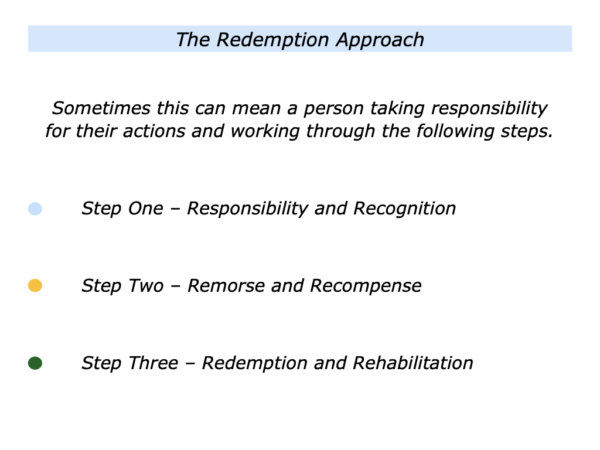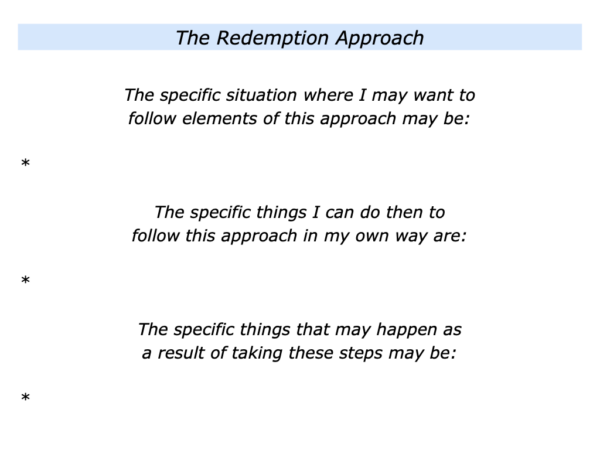
Everybody makes mistakes in life. Sometimes these only affect ourselves. Sometimes we may also do things that cause pain or problems for other people. We may do these consciously or unconsciously.
Whatever the reasons for our behaviour, we have several choices regarding how we react to what happened. We can choose:
To ignore or deny the consequences, or;
To take responsibility, recognise the consequences and act in ways that may in some way lead to atonement and redemption.
Looking back, can you think of a situation when you made a mistake that may have hurt others? What did you do to try to redeem the situation? On reflection, what else would you have liked to have done?
Imagine that a person wants to atone for their actions and seek some form of redemption. They may focus on the following themes.
Step One – Responsibility and Recognition
This involves a person taking responsibility for their actions and recognising the consequences. Every person make mistakes that do not have huge consequences. But sometimes a person may act in ways that cause serious difficulties for people.
Different individuals react in different ways. Some refuse to take responsibility. They may blame others or try to justify their behaviour. Some abusers, for example, claim that they are actually the victims.
Some people who hurt others double-down on what they have done. They may claim to be right and refuse to apologise. Some may say others are at fault for taking offence.
The first step in any recovery programme is for a person to take responsibility for their actions. They need to say something like the following.
“I am responsible for my behaviour. Whatever the circumstances, I am responsible for how I react and how I behave in the future.”
People who take this step also need to recognise the potential consequences of their actions. They may have caused pain, distress or hurt people in other ways.
Such individuals may have refused to have empathy. Whilst recognising that other people may react in different ways, they are still responsible for trying to behave in a caring way.
Imagine that a person has chosen to take responsibility and also recognised the potential consequences of their behaviour. They may then move to the next stage.
Step Two – Remorse and Recompense
This involves a person showing remorse and, where possible, aiming to make recompense for the problems they may have caused. Let’s explore how a person may take this approach.
Some individuals express true remorse and sorrow for the pain they have caused. They may feel a deep aching in their gut and not yet know how they can help to repair the situation.
Some people may not really be remorseful. They may go through the motions of shedding crocodile tears or issue statements to say they are sorry for having caused any offence.
People who are really remorseful may aim to make recompense. Sometimes this can be possible but it may also be more difficult in certain situations.
A person who has caused financial problems may be able to make financial recompense. A person who has caused physical damage to property may act to restore it to its original condition.
It is harder to make recompense for causing psychological damage. Sometimes the only way is to ensure that the people who have been hurt are provided with the right support.
This may also involve the person who caused the damage to respect the healing process that is being done. They can also show remorse by staying away from the situation and letting others get on with their lives.
Some people who show remorse and make recompense may then move on to the next stage. They may focus on the following themes.
Step Three – Redemption and Rehabilitation
This involves a person taking a path towards redemption and, as a result, sometimes towards rehabilitation. Let’s explore how a person may pursue these themes.
There are several definitions for the word redemption. The one we are using here is ‘the act of aiming to atone for guilt, a fault or a mistake’. Different people do this in different ways.
Some individuals commit themselves to following a certain moral code or a set of principles. They may follow a spiritual faith, a Twelve Step programme or do good work that helps others.
Some individuals who have transgressed ethical standards or broken the law may confess their guilt and serve a criminal sentence. They may then aim to pursue a new life where they serve other people.
People who follow this path aim to pay for their actions and lead a better life. They do not do it for any self-serving motive of feeling satisfied that they have redeemed themselves.
Some individuals may also reach of point of rehabilitation. There are several definitions for this state. The one we are using here is ‘the process of returning to or pursuing a healthy or good way of life’.
Those who take this path may find it to be a long journey. It may involve being rehabilitated in their own eyes and being rehabilitated in other people’s eyes.
They therefore focus on what they can control. They then aim: a) to follow their chosen principles; b) to be caring towards other people; c) to continue to follow this path one day at a time.
They also rehearse how to avoid or manage trigger situations that previously resulted in them going into a negative spiral. They learn how to stay calm, clarify their options and choose to follow a positive way forwards.
Such people realise that redemption and rehabilitation may be a journey rather than a destination. They therefore aim to do their best during their remaining time on the planet.
Let’s return to your own life and work. Looking ahead, can you think of a situation where you may want to follow elements of the redemption approach? How can you follow this in your own way?
If you wish, try tackling the exercise on this theme. This invites you to complete the following sentences.



Leave a Reply